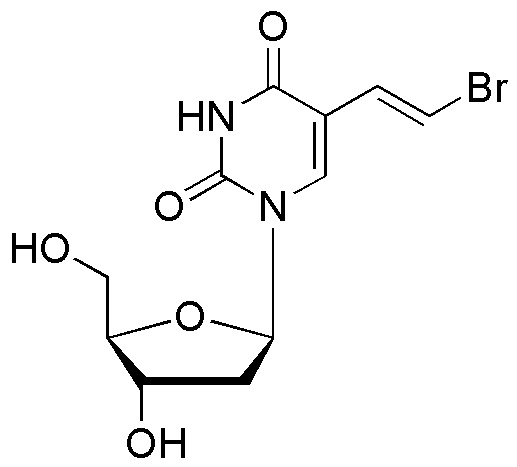(E)-5-(2-Bromovinyl)-2'-deoxyuridine is widely utilized in research focused on:
- Antiviral Research: This compound is primarily studied for its effectiveness against viral infections, particularly in the development of antiviral therapies targeting viruses like herpes simplex virus (HSV).
- Pharmaceutical Development: It serves as a key intermediate in synthesizing nucleoside analogs, which are crucial in creating new antiviral medications.
- Biochemical Studies: Researchers use it to investigate the mechanisms of viral replication and the interactions between viral components and host cells, enhancing our understanding of viral pathogenesis.
- Drug Resistance Studies: This compound helps in studying the development of drug resistance in viruses, providing insights that can lead to more effective treatment strategies.
- Clinical Research: It is involved in clinical trials aimed at evaluating the safety and efficacy of new antiviral drugs, contributing to advancements in patient care.
General Information
Properties
Safety and Regulations
Applications
(E)-5-(2-Bromovinyl)-2'-deoxyuridine is widely utilized in research focused on:
- Antiviral Research: This compound is primarily studied for its effectiveness against viral infections, particularly in the development of antiviral therapies targeting viruses like herpes simplex virus (HSV).
- Pharmaceutical Development: It serves as a key intermediate in synthesizing nucleoside analogs, which are crucial in creating new antiviral medications.
- Biochemical Studies: Researchers use it to investigate the mechanisms of viral replication and the interactions between viral components and host cells, enhancing our understanding of viral pathogenesis.
- Drug Resistance Studies: This compound helps in studying the development of drug resistance in viruses, providing insights that can lead to more effective treatment strategies.
- Clinical Research: It is involved in clinical trials aimed at evaluating the safety and efficacy of new antiviral drugs, contributing to advancements in patient care.
Documents
Safety Data Sheets (SDS)
The SDS provides comprehensive safety information on handling, storage, and disposal of the product.
Product Specification (PS)
The PS provides a comprehensive breakdown of the product’s properties, including chemical composition, physical state, purity, and storage requirements. It also details acceptable quality ranges and the product's intended applications.
Certificates of Analysis (COA)
Search for Certificates of Analysis (COA) by entering the products Lot Number. Lot and Batch Numbers can be found on a product’s label following the words ‘Lot’ or ‘Batch’.
Numéro de catalogue
Numéro de lot/série
Certificates Of Origin (COO)
This COO confirms the country where the product was manufactured, and also details the materials and components used in it and whether it is derived from natural, synthetic, or other specific sources. This certificate may be required for customs, trade, and regulatory compliance.
Numéro de catalogue
Numéro de lot/série
Safety Data Sheets (SDS)
The SDS provides comprehensive safety information on handling, storage, and disposal of the product.
DownloadProduct Specification (PS)
The PS provides a comprehensive breakdown of the product’s properties, including chemical composition, physical state, purity, and storage requirements. It also details acceptable quality ranges and the product's intended applications.
DownloadCertificates of Analysis (COA)
Search for Certificates of Analysis (COA) by entering the products Lot Number. Lot and Batch Numbers can be found on a product’s label following the words ‘Lot’ or ‘Batch’.
Numéro de catalogue
Numéro de lot/série
Certificates Of Origin (COO)
This COO confirms the country where the product was manufactured, and also details the materials and components used in it and whether it is derived from natural, synthetic, or other specific sources. This certificate may be required for customs, trade, and regulatory compliance.


